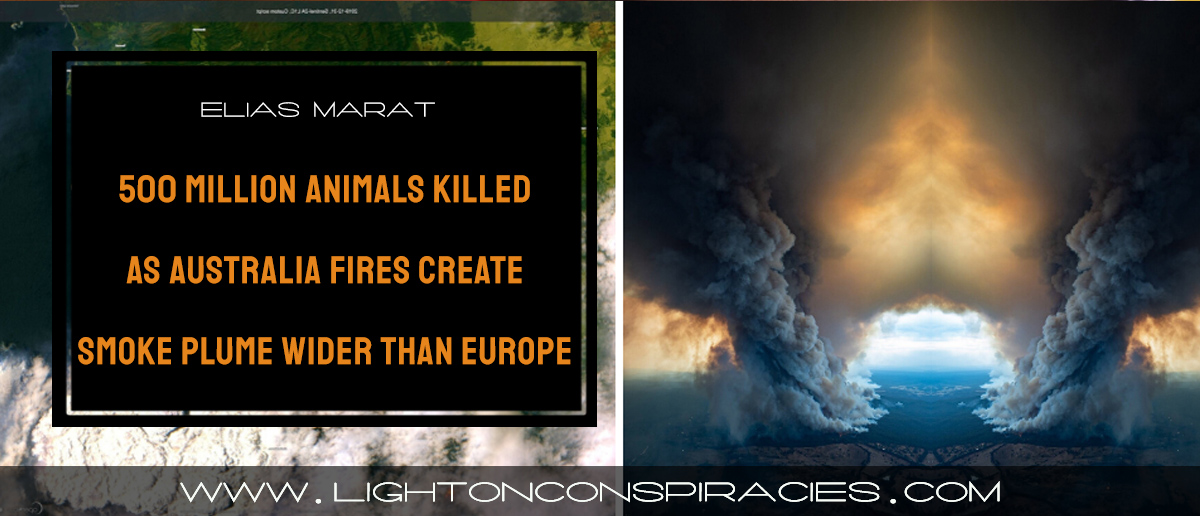(TMU) — As Australia’s horrific bushfire crisis continues unabated, smoke plumes believed to cover an area greater than that of Europe have been created while glaciers in neighboring New Zealand have been turned black by soot from the fires.
In the meantime, nearly 500,000,000 animals have been killed while the human death toll has climbed to at least 17. Experts have warned of a broader humanitarian crisis looming over the country, fueling anger at the government of Prime Minister Scott Morrison.
On Wednesday, experts noted that a massive plume of smoke spanning roughly 2.1 million square miles (5.5 million sq km) had begun drifting over the Pacific Ocean toward New Zealand, which BBC reports has been blanketed in smoke and haze from the Australia fires in recent days. The Guardian reports that vacationers have described the hazy skies in New Zealand as “sepia,” “orange” and “apocalyptic.”
Antti Lipponen, a research scientist at the Finnish Meteorological Institute, wrote in a tweet that the smoke plume is well over four times the size of Alaska, 14 times the size of Japan, and roughly equal to the distance between Iceland and Turkey.
The area of the smoke plume from #Australia fires is now almost 7.3 million sq. km! SuomiNPP / VIIRS satellite image.#NASAWorldview: https://t.co/YoqEhScJnU pic.twitter.com/psKlQiTJjR
— Antti Lipponen / @anttilip.bsky.social (@anttilip) January 2, 2020
The smoke and soot have even stained New Zealand’s iconic white glaciers, turning them black and “caramelizing” the snow in a process that could further endanger glaciers already threatened by climate change. Former New Zealand Prime Minister Helen Clark wrote in a tweet that the impact of Australian ash on glaciers “is likely to accelerate melting.”
Snow and ice usually reflect the sun’s heat and slows melting while white. However, snow blackened by ash and dust rapidly absorbs heat and therefore melts at faster rates.
Huge smoke plume showing up on GOES-17 from the Australia fires.
Currently being wrapped up by a low pressure system over the Pacific. pic.twitter.com/OUwk0I4E8P
— Dakota Smith (@weatherdak) January 2, 2020
The environmental calamity has been stoked by a combination of extreme winds, record-shattering heat waves, and drought-parched forests, grasslands, and brush. Australia’s bushfires have also grown so monstrous that they are generating their own weather in the form of pyro-cumulonimbus clouds—or thunderstorms that create more fires—according to Victoria’s Bureau of Meteorology.
Weather forecasts have predicted continued withering hot conditions and fierce winds across southern Australia on Friday as well as dangerous bushfire conditions in eastern Victoria and New South Wales (NSW) on Saturday. Thousand of firefighters, including huge numbers of volunteers, have been fighting the over 100 fires in NSW and over 40 in Victoria.
Near Franz Josef glacier. The “caramelised” snow is caused by dust from the bushfires. It was white yesterday pic.twitter.com/Ryqq685Ind
— Fabulousmonster (@Rachelhatesit) December 31, 2019
The nightmarish nature of the crisis took a new form over the weekend as 4,000 people in the coastal town of Mallacoota, Victoria, fled to the shore and even into the water as the blaze threatened to consume their homes.
Tourist Kai Kirschbaum told ABC Australia:
“I think that was our biggest threat in terms of what are we doing with the children if we need to go in the water to protect ourselves given the fact that they are only 1, 3 and 5.
If you’re a good swimmer it doesn’t really matter if you have to be in the water for a longer time, but doing that with three kids that would have been, I think, a nightmare.”
In the meantime, ecologists are fearing a tremendous tragedy for wildlife as nearly 500 million mammals, reptiles and birds—including 8,000 koalas—are estimated to have been killed. The massive loss of life threatens to forever tip the balance for entire species of animals and plants.
Over 300 baby flying foxes were abandoned by their mothers who were trying to survive by any means, according to experts.
Australia’s bushland is home to a range of indigenous fauna such as kangaroos, koalas, wallabies and possums. Authorities have no exact figure on how many native animals have been killed in the bushfires but experts say it is likely to be in the millions https://t.co/NXoEkxAlxP pic.twitter.com/yP2VUYBLeS
— Reuters (@Reuters) December 30, 2019
Wildlife rescuer Jenny Packwood told the Sydney Morning Herald:
“Mothers are abandoning babies at two weeks after birth because there is no food for them. Last week we had 300 come in, and we’ve been flat out feeding since then.
I’ve never seen anything like this before—we’re calling it a starvation event.”
Species like bats also face the threat of local extinction from the massive obliteration of small creatures such as insects in wildfire-impacted regions, thre Independent reported.
Koala Crisis wrote on Facebook:
“Not one carer KC has spoken to has seen bees, insects, grubs, worms, snails, beetles, millipedes, for months. Nothing struggles through the dustbowls which are now covering millions of hectares in all states.
There’s no grass for the ’roos, no insects for the birds, the leaves on eucalypts are brittle, ensuring starvation for koalas, gliders, possums, birds, insects.”
The bushfires devastating Australia have been raging since September, laying waste to wildlife and private property alike. Experts are fearing that a humanitarian crisis is imminent as the country faces the worst fire season in recorded history with three more months of the summer season left.
Along with the fires, arid conditions due to a prolonged drought have wrought devastation on the livelihoods of farmers and local economies.
The Australian government, headed by Prime Minister Scott Morrison, has been accused of denying the realities of climate change despite its belated verbal acknowledgment that changing climate conditions have played a role in the crisis. The government has been accused of obstructing global summits on climate change and skirting its obligations under the 2015 Paris accord while doing little to curtail the country’s role as the world’s number one exporter of coal and liquefied natural gas.
Australians’ anger toward the prime minister—who has derisively been nicknamed “ScoMo” or “Scummo”—was abundantly clear Thursday when he was forced to scrap a meet-and-greet with locals in a fire-scourged NSW town. As the beleaguered prime minister attempted to reassure residents, locals showered abuse on him.
The Guardian quoted residents cursing Morrison as “an idiot,” telling him that he’s “not welcome” and should “piss off” and not expect any future votes.
Scott Morrison forcing this woman to shake his hand, then ignoring her and walking away when she tells him she doesn’t want a handshake unless he gives more funding to the RFS, is fucking disgusting – even by his low standards. #bushfiresAustralia #auspol pic.twitter.com/LX6agg3S7G
— Brendan Bradford (@1bbradfo) January 2, 2020












